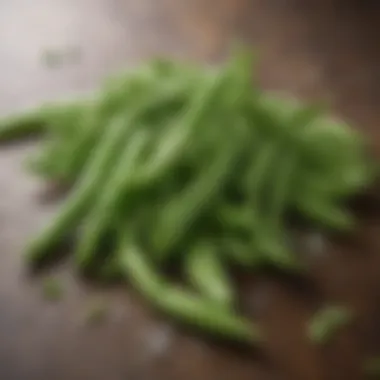Exploring the Versatility of Chinese Snow Peas


Intro
Chinese snow peas hold a distinct place in the culinary landscape. Their unique characteristic is the edible pod. Crisp and sweet, they add both texture and a satisfying flavor to various dishes. A foray into the realm of snow peas reveals their origins, versatility, and how they can become indispensable in both everyday cooking and elaborate meals. This guide is crafted to help both novices and seasoned chefs make the most of this delightful ingredient.
Ingredients Breakdown
Primary Ingredients
Chinese snow peas are the focal point of any dish featuring them. When shopping, look for bright green pods free from blemishes. Alternatively, incorporate the following as primary nutrition enhancers:
- Fresh snow peas
- A mild oil (like canola or sesame) for stir-frying
- In certain recipes, garlic or ginger adds depth.
Optional Ingredients
Snow peas integrate beautifully with various foods. Some optional ingredients include:
- Carrots, julienned
- Bell peppers, sliced
- Proteins like chicken breast or tofu
- Green onions, for garnish
- Soy sauce or oyster sauce, to enhance flavor.
Essential Kitchen Tools
Each kitchen should have fundamental tools for working with snow peas. Among these tools are:
- A sharp knife and chopping board for prepping
- A non-stick skillet for stir-frying
- Steamer basket, for optimal cooking without losing nutrients
- Measuring spoons and cups, if preparing with measured ingredients.
Step-by-Step Preparation
Prepping the Ingredients
The initial step in preparing snow peas demands some attention. Rinse them under cold water to remove any dirt or residues. Trim the stem end. Removing the strings is optional, yet some find the texture smoother once done.
Cooking Techniques and Methods
Furthermore, there are multiple techniques available. Snow peas can be:
- Stir-fried for a quick, crisp finish
- Blanched briefly to retain vibrant color and nutritional value
- Steamed to maintain flavor without adding excess fat.
Each method presents its advantages, revealing distinct textures and flavors.
Assembly and Presentation Tips
For an appealing dish, consider balancing colors and ingredients. Lay the snow peas atop a bed of vibrant vegetables. At the same time, sprinkle fresh herbs like cilantro or parsley for a touch of liveliness. Presenting food attractively elevates its perceived taste.
Dietary Considerations
Gluten-Free Options
Snow peas are inherently gluten-free. This makes them an excellent choice for those needing gluten-free diets.
Vegetarian and Vegan Substitutes
Using snow peas aligns with vegetarian and vegan diets. The addition of tofu or plant-based proteins enhances nutritional content while preserving essential vitamins.
Nutrition Facts & Nutritional Considerations
In dietary circles, it is well-acknowledged that snow peas provide a good balance of vitamins A and C, offering a healthy amount of fiber while keeping calories low. Each serving (approximately 100 grams) yields:
- Calories: 42
- Protein: 3 grams
- Dietary Fiber: 3 grams
- Carbohydrates: 7 grams
Appropriately nutritional, they supplement any meal convincingly.
Variations and Customizations
Flavor Enhancements
Experimenting with snow peas can lead to rich flavors. Adding sesame oil can intensify Asian-inspired dishes. Moreover, consider citrus zest for an invigorating twist.
Alternative Cooking Methods
Explore further options in the kitchen:


- Grill them for a smoky flavor
- Incorporate them in soups or stews for added fiber
Versatility remains one of their charm.
Pairing Suggestions
Selecting the right accompaniments heightens enjoyment. For sides, try:
- Jasmine rice, complementing typical Asian flavors
- Grilled fish, as lean protein sources
- Fresh salads to serve cold textures with contrast.
You could also opt for pairing with light wines or fruity beverages to match your dishes.
Common Help Sections and Troubleshooting
Frequently Asked Questions
This section addresses common inquiries:
- What is the best cooking time for snow peas?
Quick cooking is advised; around 2-3 minutes for stir-frying often works well.
Common Mistakes to Avoid
Avoid overcooking; it drags down the taste and nutritional value. Remove them from heat promptly; vibrant color and crunch are ideal.
Solutions to Potential Problems
Anyone may encounter minor frying mishaps. If they burn, recent batches should be kept in mind. Use lower heat and ample oil, and ensure you don’t overcrowd the pan.
In summary, Chinese snow peas offer a versatile spectrum for any kitchen, presenting numerous health benefits and a rich foundation for countless dishes.
Intro to Chinese Snow Peas
Chinese snow peas are a fascinating topic which encompasses various aspects, such as nutrition, culinary practices, and delightfully unique characteristics. Their significance as a fresh ingredient in global cuisines adds layers to their exploration.
Importance and Key Elements
Snow peas are not just another vegetable; they are loaded with vitamins and minerals that contribute positively to one's health. Their role extends beyond internal health benefits, influencing culinary styles, preparation methods, and flavor profiles. Understanding snow peas is helpful for both novice cooks and seasoned culinary experts seeking to innovate or perfect their dishes.
Definition and Characteristics
Snow peas, scientifically known as Pisum sativum var. saccharatum, stand out due to their tender pods which are edible and are a brilliant green in color. The pods are flat and tender, showing small peas inside. Snow peas have a crisp texture, making them ideal for stir-frying or as a side to many dishes. They are known for a milder flavor compared to garden peas and boast a slight sweetness.
Some key characteristics include:
- Flat, crisp edible pods
- Mild sweet flavor
- Bright green color
- Excellent source of dietary fiber and vitamins C and K
Additionally, snow peas thrive in cooler climates, which enhances their identity as a seasonal vegetable in various regions, particularly in Asia.
History and Origin
Snow peas have a rich history that spans thousands of years. Their exact origin is still a topic of debate, but it is widely understood that these peas originated in ancient Asia. The use of snow peas in traditional Chinese cuisine dates back centuries, serving as a staple ingredient during various dynasties.
Cultivation methods during these historical ages were significantly shaping their attributes, balancing between human cultivation efforts and climate impacts. It is significant to trace their alterations in cultivation to understand how they enhanced nutritional value. Their introduction to regions like Europe and the Americas later on played a crucial role in diversified culinary methods today.
Nutritional Profile of Snow Peas
The nutritional profile of snow peas is quite impressive and significant for any food lover or health enthusiast. Snow peas, often regarded as a delicacy in Asian cuisine, offer various micronutrients essential for maintaining overall health. Understanding their vitamin and mineral content is essential not just for culinary applications but for their role in fostering balanced nutrition in diets.
Vitamins and Minerals
Snow peas are rich in vitamins and essential minerals that contribute to improved well-being. Here is a detailed overview of some important nutrients found in snow peas:
- Vitamin C: This vitamin plays a critical role in enhancing the immune system. Snow peas offer a substantial dose of Vitamin C, which aids in the body’s ability to heal wounds and absorb iron.
- Vitamin K: Known for its role in blood clotting, Vitamin K is another key nutrient present in snow peas. Its effects on bone health are also notable, which is useful for maintaining a strong skeletal structure.
- Folate: This is crucial during pregnancy and for cellular development. Consuming snow peas can provide a good amount of folate, promoting DNA synthesis and proper cellular functions.
- Iron: Snow peas contain iron, which is essential for producing hemoglobin, assisting in blood oxygen transport throughout the body.
By incorporating snow peas into your diet, you can enrich your nutrient intake effortlessly.
Other minerals present include potassium and magnesium, which are vital for muscular and nerve functions. Available in sufficient quantity, they also assist in maintaining heart health.
Health Benefits
The numerous health benefits of consuming snow peas are worth noting. Here are a few:
- Low Calorie Content: Snow peas are low in calories, making them an ideal snack or meal addition for weight management focused individuals.
- High Fiber Content: They contain dietary fiber that is beneficial for digestive health. Fiber helps in bowel health and regulates blood sugar levels, benefiting those who monitor their glucose.
- Antioxidant Properties: With various antioxidants, snow peas help combat free radicals. This can lower the risk of chronic diseases such as heart disease and cancer.
- Anti-inflammatory Effects: Some compounds in snow peas have anti-inflammatory qualities, reducing the risk of developing chronic inflammatory conditions.


Incorporating snow peas into regular meals is not only a way to add crunch and flavor but also to enhance health through a food that is nutrient-packed and versatile.
Culinary Uses of Chinese Snow Peas
Chinese snow peas are not just a vegetable, but an essential ingredient in various dishes that combine taste and health benefits. The culinary uses of snow peas reflect their unique texture and flavor, making them an important part of many recipes. With their sweet taste and crisp feel, these peas bring freshness and balance to Vietnamese, Chinese, and other Asian cuisine. They also find their way into modern cooking, allowing for innovation and new flavor combinations.
Traditional Dishes
In various Asian cultures, snow peas have long been a staple. Phở is a famous Vietnamese dish enriched with an assortment of vegetables, often featuring snow peas for added sweetness and crunch.
Another traditional dish is Chinese stir-fried mixed vegetables. Often prepared in a wok, this dish shows off snow peas alongside carrots, bell peppers, and mushrooms. Together, they create a balance of colors and flavors, so attractive to the palate.
Additionally, snow peas can be found in lemon garlic dishes.
- The vibrant pea creates a surprising pairing with garlic’s strong taste.
- This blend delights the taste buds and serves to elevate the dish’s presentation.
Snow peas are also sometimes included in Asian salads, offering a crisp texture and sweet flavor while promoting freshness in the dish. Compatibility with various greens and dressings enhances their popularity in salads.
Modern Adaptations
As culinary practices evolve, so do the uses of traditional ingredients like snow peas. Recent trends in health-oriented cooking shine a light on snow peas. Their adoption in meal prep boxes and home deliveries illustrates their rising popularity among health-conscious consumers.
Contemporary chefs utilize snow peas in gourmet dishes, presenting them in innovative ways. One can encounter snow peas in:
- Wraps or tacos: This trend encourages wrapping different proteins in lettuces, and snow peas serve as the surprising crunch that contrasts nicely.
- Smoothies: Chef experimentation has introduced snow peas into smoothies. Packed with nutrients, they lend their freshness, contributing to a nutritional powerhouse without significantly altering taste.
- Grain bowls: Bowls containing rice or quinoa topped with vegetables have become popular. Ice-cold, blanched snow peas add crispness to these meals.
Using snow peas in various modern contexts speaks volumes about the ingredient’s versatility. It shows not only their role in classic dishes but also their adaptability to fuel contemporary culinary trends.
Snow peas bring together a delightful combination of taste and nutrition that appeals to both traditional enthusiasts and modern culinary innovators.
Preparation Techniques
Preparation techniques are essential in ensuring the best flavors and textures when working with Chinese snow peas. Knowing how to properly select, store, and cook these peas can drastically enhance their taste and nutritional value. Good preparation not only optimizes their crispness but also allows their natural sweetness to shine through in various dishes. Understanding these techniques is crucial for both amateurs and seasoned chefs alike.
Selection and Storage
Choosing the right snow peas begins with careful selection. Look for fresh peas that have a bright green color and a firm texture. The pods should be plump and crisp, without any wrinkles or blemishes. Gently snap one pod to test its freshness — if it snaps easily, it is likely fresh.
Storage is just as vital as selection. Store snow peas unwashed in the refrigerator, ideally in a produce bag, to maintain their moisture. They are best consumed within a week of purchase. If you realize you have surplus peas, consider freezing them. To freeze, blanch them in boiling water for two minutes, then cool them in ice water before transferring to a freezer-safe container. This helps preserve their taste and texture.
Cooking Methods
Chose the right method of cooking to highlight the unique characteristics of snow peas. There are several methods each offering distinct flavors and textures.
Steaming
Steaming is one of the most common methods for cooking snow peas. This method particularly highlights the natural sweetness of the peas, retaining their bright green color and crisp texture. The key characteristic of steaming is that it requires minimal cooking time. This not only preserves nutrients but also makes the snow peas tender yet crunchy.
When considering steaming, it's essential to avoid overcooking. Over-steamed peas lose their bright color and can become mushy. Thus, it is advisable to steam for just 2 to 3 minutes.
Steaming enhances flavors while preserving nutrients, making it a best practice for cooking snow peas.
Stir-frying
Stir-frying snow peas allows for a quick cooking time while also combining them with other ingredients such as garlic or sesame oil. The heat from stir-frying elevates the flavors and can incorporate a nice smokiness. The key characteristic of stir-frying is its speed. This method maintain crispness while still allowing for caramelization, leading to a full-bodied taste.
A unique feature of stir-frying is the high heat used, which enables the oills and the natural sugars in the peas to come to the surface. While it is a popular method, careful monitoring is required to prevent burning.
Raw Consumption
Raw consumption of snow peas is perhaps the purest way to enjoy their taste. This method retains all the nutrients without any loss from cooking. The notable aspect of raw consumption is how the crunchy texture and sweet flavor offer a refreshing snack. Many enjoy them in salads or as a crisp partner to dips.
One advantage of consuming raw snow peas is that it's quick and easy. However, this might not appeal to all, as some people prefer cooked textures over raw. Nonetheless, providing crunchiness in salads or as a snack makes it a valuable preparation method whose benefits should not be overlooked.
Gardening and Cultivation of Snow Peas
Growing snow peas at home can be a rewarding activity. The gardening requires understanding specific conditions and management practices. This section will guide you through these essential elements of snow pea cultivation.


Ideal Growing Conditions
Snow peas thrive in temperate climates. The ideal temperature for germination of seeds is between 55°F to 75°F. Higher temperatures can be detrimental to the plants. Also, snow peas prefer well-draining soil that is rich in organic matter. A slightly acidic to neutral pH of around 6.0 to 7.0 works best.
When preparing the garden soil, consider adding compost. This feeds the plants and improves texture of the soil. Full sun exposure is important as well. Aim for at least 6-8 hours of sunlight for optimal growth. Keep in mind to sow seeds early in spring or even in late fall for a winter harvest.
Proper conditions can drastically impact the yield and taste of your snow peas.
Overall, maintaining these ideal conditions is crucial for robust growth and high productivity.
Pest and Disease Management
Pest and disease interference can disturb the growth of snow peas. Therefore, management is significant. Regularly inspect your plants for common pests like aphids, spider mites, and cucumber beetles. These can be controlled by using insecticidal soap or neem oil, which are effective but gentle alternatives. It is essential to treat infestations early.
Disease can occur, too. The most common issues for snow peas are powdery mildew and root rot. Proper spacing between plants helps improve air circulation. Furthermore, rotating crops can break disease cycles and promote soil health. If roots are overly saturated, it increases risk of rot. Maintaining a balanced watering schedule can help avoid this problem.
Cultural Significance
The cultural significance of Chinese snow peas extends beyond their culinary applications. These peas play a vital role in various cuisines across Asia, particularly due to their versatility and flavor profile. Eating snow peas relate to community shared meals and festive occasions, forming connections among families and friends.
In Asian Cuisine
In Asian cuisine, snow peas are more than just a popular addition to dishes; they symbolize freshness and health. They appear in various dishes across different cultures, enhancing color and crunch.
- Stir-fries: In Chinese cooking, snow peas frequently appear in stir-fries. They blend together seamlessly with other vegetables and meats, resulting in vibrant, visually appealing meals. They retain their bright green color while offering a unique texture that complements numerous ingredients.
- Soups: In Asian soups, snow peas add both nutrition and aesthetic appeal. Their natural sweetness offsets savory flavors, creating a well-rounded dish.
- Side Dishes: Snow peas are often served as a side dish. Simple preparations, such as steaming or blanching can enhance their natural flavors without overpowering them.
Moreover, its inclusion in traditional dishes reflects local agricultural availability and farmers’ market trends, reinforcing the unique identity of regions. Festivals often incorporate dishes containing snow peas, honoring this vegetable's contribution to cultural heritage.
Global Adaptation
The introduction of snow peas into global cuisine exemplifies how food travels beyond its geographic origins. Their light, crisp texture and bright flavor make snowy peas appealing to chefs and home cooks alike.
- Fusion Dishes: In contemporary cooking, particularly in Western nations, snow peas are used in fusion cuisine. Combining diverse culinary traditions allows chefs to experiment. For instance, they feature in salads, pasta dishes, and as garnishes in Western entrée.
- Commercial Foods: Packaged and processed foods utilize snow peas to enhance visual appeal. Their vibrant color captures consumer attention. Salads featuring snow peas can provide healthy options at restaurants and cafes, catering to health-conscious diners.
Taste preferences around the world have led to increased cultivation and interest in snow peas, resulting in expanded availability. This adaptation reflects broader trends in consumer eating habits. As chefs and home cooks seek out sharp flavors and healthful ingredients, snow peas hold a place in a modern stars of global dining.
Snow peas serve as a connector between cultures, emphasizing food’s ability to bring people together and their role in both tradition and innovation across menus worldwide.
Recipes Featuring Snow Peas
Chinese snow peas bring valuable nutrition, flavor, and a delightful crunch to a variety of dishes. Those familiar with this unique vegetable understand its versatility. Exploring recipes featuring snow peas is essential as it allows cooks of all skill levels to incorporate adventure into their culinary practices. Recipes that showcase snow peas can elevate meals, enhance flavors, and make the most of this nutritious ingredient. This section emphasizes different types of dishes that highlight snow peas, offering brackets for innovation.
Appetizers
Appetizers featuring snow peas can provide vibrant visual appeal and fresh flavors, acting as an excellent start to any meal. They also offer nourishment in small and delightful portions. Simple yet effective recipes, such as snow pea and shrimp rolls, are perfect for gatherings. Wrapping crunchy snow peas with marinated shrimp and fresh herbs inside rice paper creates an enticing starter.
Another option is snow pea salsa. Grated snow peas mixed with diced tomatoes, onions, and cilantro produce a zesty dish that performs well together with tortilla chips. Picking recipes that include dip options ensures a crowd-pleasing exploration of flavors. Offer options to accommodate dietary preferences or mix texture and flavors for layered taste experiences.
Salads
Salads enriched with snow peas serve as exciting plates filled with textures and nutrition. When combined with other salad ingredients, they offer not just nutrition, but a refreshing crunch. One quick recipe is a snow pea and quinoa salad. Toss cooked quinoa with snow peas, cherry tomatoes, and light vinaigrette. This quick, nutrient-rich meal can serve as a light lunch or an exciting side dish.
It’s interesting to experiment by adding nuts for texture. Nuts such as almonds or cashews complement the flavor of snow peas very well. Highlight the importance of color and variety of ingredients in salads to fulfill both health benefits and presentation.
Main Courses
Main courses present a great opportunity to feature snow peas prominently, infusing size and flavor into heartier meals. A stir-fry is a classic method to use snow peas, allowing them to maintain their crispness. Ingredients like bell pepper, tofu, and a soy sauce base create harmony in this fast-cooking dish. Including protein elements makes this recipe a substantial option while still remaining light. It’s simple for anyone to prepare a version that suits different preferences by substituting or mixing types of protein, including chicken, beef, or herbivore-friendly selections.
Integrating snow peas into a pasta dish adds vibrancy. Cooking tagliatelle or fettuccine while tossing snow peas can enhance flavor diversity. Usage of olive oil, garlic, and a touch of parmesan can yield a comforting meal.
Incorporating dishes that center snow peas are crucial for maximizing their potential in the culinary world. Not only do these recipes alongside flavor variety focus on nutrition, they encourage creativity in the kitchen.
The End
Moreover, the culinary uses highlight the appeal of Chinese snow peas in traditional dishes as well as modern interpretations. Snow peas add a crisp texture and bright flavor, proving their adaptability across different cooking styles. Their contribution to taste and aesthetic in various recipes, such as appetizers and main courses, ought not to be overlooked by chefs of any experience level.
For enthusiasts looking to cultivate their own snow peas, understanding ideal growing conditions and effective pest management is essential. With gardening, the process can be rewarding and satisfying, ensuring access to fresh and flavorful produce.
As people embrace more diverse flavors and dishes, the global adaptation of snow peas signifies their relevance in contemporary cuisine. Recognizing and respecting cultural significance deepens our understanding of this ingredient.
Importantly, Chinese snow peas are not just a culinary item, but a bridge between tradition and innovation, encouraging exploration and creativity in the kitchen.
Thus, by synthesizing information from various sections of this article, readers are equipped with the knowledge that can enhance their appreciation and use of Chinese snow peas. Embracing these elements paves the way for enriched culinary experiences, encouraging food lovers of all ages to experiment with this vibrant and nutritious ingredient.







